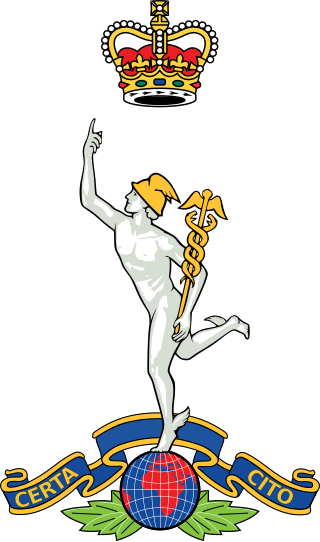
Brigade of Gurkhas is the collective name which refers to all the units in the British Army that are composed of Nepalese Gurkha soldiers. The brigade draws its heritage from Gurkha units that originally served in the British Indian Army prior to Indian independence, and prior to that served for the East India Company. The brigade includes infantry, engineering, signal, logistic and training and support units. They are known for their khukuri, a distinctive heavy knife with a curved blade, and have a reputation for being fierce and brave soldiers.

The Royal Corps of Signals is one of the combat support arms of the British Army. Signals units are among the first into action, providing the battlefield communications and information systems essential to all operations. Royal Signals units provide the full telecommunications infrastructure for the Army wherever they operate in the world. The Corps has its own engineers, logistics experts and systems operators to run radio and area networks in the field. It is responsible for installing, maintaining and operating all types of telecommunications equipment and information systems, providing command support to commanders and their headquarters, and conducting electronic warfare against enemy communications.

16 Air Assault Brigade Combat Team, known simply as 16 Air Assault Brigade from 1999 – 2021, is a formation of the British Army predominantly based in Colchester, Essex. It makes up the Air Assault Task Force, a battlegroup held at high readiness, and is the only brigade in the British Army focused on operating via parachute, helicopter and air-landing.

The 20th Armoured Brigade Combat Team, previously the 20th Armoured Infantry Brigade, is an armoured infantry brigade formation of the British Army, currently headquartered at Wing Barracks, Bulford, Wiltshire, as part of the 3rd Division.
The 19th Brigade is an Army Reserve formation of the British Army. As the 19th Infantry Brigade, it fought in the First and Second World War.

The 11th Signal and West Midlands Brigade was a signal formation of the British Army's 3rd UK Division. By November 2024, it had been disbanded, with its sub-units resubordinated.

Bulford Camp is a military camp on Salisbury Plain in Wiltshire, England. Established in 1897, the site continues in use as a large British Army base. The camp is close to the village of Bulford and is about 2+1⁄4 miles (3.6 km) north-east of the town of Amesbury. The camp forms part of the Tidworth, Netheravon and Bulford (TidNBul) Garrison.

The 14th Signal Regiment (Electronic Warfare) is a part of the British Army's Royal Corps of Signals. The regiment's role is to provide electronic warfare (EW) capability in support of deployed Land Commanders, in order to enable operations in the electronic battlespace. It is the only British Army regiment capable of conducting sustainable electronic warfare in support of national operations worldwide. The regiment is currently based at Cawdor Barracks, on the site of the former RAF Brawdy, near Haverfordwest, in South Wales.

The 1st Signal Brigade, formerly known as the 1st Signal Group, is a brigade of the British Army. The group was first formed in 1968 as a result of the 1966 Defence White Paper which expanded support for NATO and the British Army of the Rhine. In 1987, the group was disbanded and merged into the 2nd Signal Brigade. In 1995, the brigade was reformed and has since deployed on operations across the globe in support of NATO and HQ Allied Rapid Reaction Corps.

8th Engineer Brigade is an engineering support formation of the British Army, under the command of HQ Allied Rapid Reaction Corps, supporting NATO.

The page contains the current structure of the British Army. The British Army is currently being reorganised to the Future Soldier structure.
The following is a hierarchical outline for the structure of the British Army in 1989. The most authoritative source for this type of information available is Ministry of Defence, Master Order of Battle, and United Kingdom Land Forces, HQ UKLF, UKLF ORBAT Review Action Plan, HQ UKLF, 1990.

The 7th Signal Regiment was a regiment of the Royal Corps of Signals within the British Army. The unit and its predecessors supported 1st (British) Corps from 1911 until the end of the Cold War. Afterwards the regiment supported the Allied Rapid Reaction Corps until its disbandment in 2012.
1 Signal Regiment is a military communications regiment of the British Army. The regiment is now part of the 11th Signal Brigade.

2 Signal Regiment is a signal regiment of the Royal Corps of Signals within the British Army.
10 Signal Regiment is a signal regiment of the Royal Corps of Signals within the British Army.
13 Signal Regiment is a signal regiment of the Royal Corps of Signals within the British Army.

The 15th Signal Regiment is military communications unit of the British Army's Royal Corps of Signals.

The Field Army is a command of the British Army responsible for generating and preparing forces for current and contingency operations. Commander Field Army reports to the Chief of the General Staff.
Future Soldier is a reform of the British Army resulting from the Integrated Review of Security, Defence, Development and Foreign Policy published in March 2021. The aim of the reform is to create a more lethal, agile and expeditionary force, able to fight and win wars and to operate in the grey-zone between peace and war. Future Soldier was published on 25 November 2021 and deals with the organizational changes of the British Army, with changes to personnel and equipment were set out in the Defence in a Competitive Age paper published on 22 March 2021.











